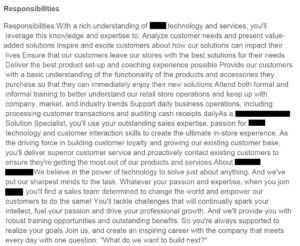Numbing Job Descriptions and How to Fix Them

People are always saying things like, dress for the job you want not the job you have, or tailor your resume/cover letter for each position you apply for. Well HR employees need to take note and start doing the same thing with job descriptions; tailor your job descriptions for the candidates you’d like to attract.

Job descriptions are written by people, so why do they often sound like they were produced by robots? Robotic lists and numbing paragraphs (like the one to the left) are not interesting or enticing to any candidates. Attracting top talent starts by getting the right people to apply for your position. So, how do you write an interesting job description? You need to sell it! Be informal, yet sincere. Talk to the candidate as you would your friend, let them know what a day in the life would really look like. You want the employees to like their daily duties, and be inspired. Use the job description as a brief introduction to your company and the position.
There are many ways to set up a job description and since you will likely be speaking to different people for each position I don’t suggest using a template, but there are a few general rules to follow for all job descriptions.
- They should be short and sweet, fewer bullets and paragraphs, more notes and phrases. All job descriptions should have a few sentences
explaining the company and the position, a couple of bullet points on daily tasks and requirements, and a short blurb to illustrate the culture. Nowadays people are mobile, we are
always on our phones or tablets or laptops. With that in mind, your job description should be legible from someone’s smartphone. Cut out the lengthy paragraphs and all that business jargon. Get to the point. Distinguish the must-haves from the nice to haves. What is absolutely required versus what would be great, but you can do without? People don’t want to scroll and scroll and scroll just to find out they don’t even meet the requirements. - Keep it tailored; if you are looking for a veteran engineer they might prefer a good retirement plan and 401K whereas a recent grad might be more interested in in-office perks such as free lunches and good PTO benefits. Let people know what you and the company have to offer them.
- Be real. Show potential candidates your personality. People want to work for people they like. Let them know who they would report to and what kind of team they would be joining. Some companies even include LinkedIn links so candidates can look at team members’ profiles.










Comments
Comments
Powered by WP LinkPress